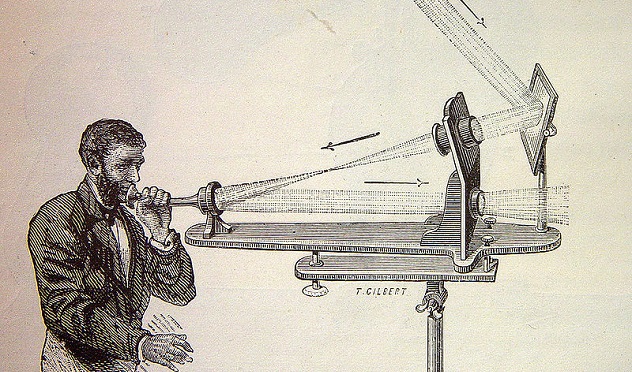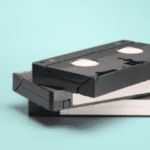 Weird Stuff
Weird Stuff  Weird Stuff
Weird Stuff  Our World
Our World 10 Ways Your Christmas Tree Is More Lit Than You Think
 Movies and TV
Movies and TV The 10 Coolest Stars to Set Sail on The Love Boat
 History
History 10 Things You Didn’t Know About the American National Anthem
 Technology
Technology Top 10 Everyday Tech Buzzwords That Hide a Darker Past
 Humans
Humans 10 Everyday Human Behaviors That Are Actually Survival Instincts
 Animals
Animals 10 Animals That Humiliated and Harmed Historical Leaders
 History
History 10 Most Influential Protests in Modern History
 Creepy
Creepy 10 More Representations of Death from Myth, Legend, and Folktale
 Technology
Technology 10 Scientific Breakthroughs of 2025 That’ll Change Everything
 Weird Stuff
Weird Stuff Ten Bizarre Facts About The Doge Meme
 Our World
Our World 10 Ways Your Christmas Tree Is More Lit Than You Think
 Movies and TV
Movies and TV The 10 Coolest Stars to Set Sail on The Love Boat
Who's Behind Listverse?

Jamie Frater
Head Editor
Jamie founded Listverse due to an insatiable desire to share fascinating, obscure, and bizarre facts. He has been a guest speaker on numerous national radio and television stations and is a five time published author.
More About Us History
History 10 Things You Didn’t Know About the American National Anthem
 Technology
Technology Top 10 Everyday Tech Buzzwords That Hide a Darker Past
 Humans
Humans 10 Everyday Human Behaviors That Are Actually Survival Instincts
 Animals
Animals 10 Animals That Humiliated and Harmed Historical Leaders
 History
History 10 Most Influential Protests in Modern History
 Creepy
Creepy 10 More Representations of Death from Myth, Legend, and Folktale
 Technology
Technology 10 Scientific Breakthroughs of 2025 That’ll Change Everything
10 Modern Technologies Far Older Than You Think
Mark Twain once said, “There is no such thing as a new idea. It is impossible. We simply take a lot of old ideas and put them into a sort of mental kaleidoscope.”
As with most things, Twain was absolutely right. Even a lot of “modern technologies” are really just updated versions of older creations, polished and given a fresh coat of paint.
10 Video Games
The general consensus is that the history of video games began with Pong. But in reality, these games had been entertaining us long before Pong’s release in 1972. Back in 1958, Dr. William Higinbotham was working at Brookhaven National Laboratory, designing a simulation to calculate the trajectories of missiles and bouncing balls. He had a moment of inspiration during his research when he realized his creation could be used for entertainment.
Higinbotham called his new game Tennis for Two, and it used trajectories to bounce a “tennis ball” (represented by a point of light) around a court, with a net in the middle. The screen was a 12.7-centimeter (5 in) oscilloscope, and the game was controlled by a large box with a rotating knob. Tennis for Two never hit stores because it was extremely similar to a design Higinbotham had used in a federal-owned lab, meaning the US government would’ve owned the game should he try to commercialize it.
But even before Tennis for Two, there was the Cathode Ray Tube Amusement Device. Patented in 1948, this was a massive, closet-mounted cathode ray computer. As for the gameplay itself, knobs were used to adjust the speed and trajectory of an artillery shell that the player aimed at a predestined point on the screen.
These points were overlain with transparent pictures of airplanes. In other words, the airplane images were actually placed on top of the screen. (After all, this was the ‘40s, and the level of graphical detail needed for an in-game plane would’ve been impossible.) Next, the player would try to hit the target by maneuvering his artillery shell toward the preset point/airplane. If the player managed to hit the target, the shell would blur, simulating an explosion.
9 Mobile Phones
Mobile phones have been around for a lot longer than you would probably suspect. The first “true” mobile telephone call was made in 1946. Long before iPhones, a team at Bell Labs had already made a wireless phone service available in about 100 cities.
Naturally, it was expensive, with a monthly service fee of $15. That’s about $150 by today’s standards, with an additional fee of 30–40 cents per call. And since the equipment weighed about 36 kilograms (80 lb), the “mobile” function was mainly limited to automobiles. In addition to the price and weight, it was also a party line that could only handle about three calls at one time in one city. Due to its price and technological limitations, it was far from popular.
But there was a slightly more viable option in 1922. Although this device was labeled a “wireless telephone,” it was not what we could consider a mobile phone today. Nevertheless, it was a way to wirelessly connect with family members over great distances, and in the 1920s, that was quite an achievement.
The device was a kind of one-way crystal radio that was used to listen to messages. It was large and required an umbrella to act as the antenna. However, it didn’t need a power source since the antenna provided the energy. Old advertisements for the phone appealed to women who wanted to call their husbands wherever they were at the moment. Of course, that also meant hubby had to carry the bulky radio and constantly listen for the phone call. Given all that, it’s not surprising this particular device never caught on.
8 Bras
The first modern bra was patented in 1914. It’s said that Mary Phelps Jacob created the undergarment as a way to have support without wearing a corset, which she said was like wearing whalebone armor. Her bra was essentially two handkerchiefs sewn together and tied around the neck. It was not very comfortable, but compared to corsets, the bra was far lighter and less restrictive.
Still, in Jacob’s time, corsets were all the rage, so women would only wear bras in the privacy of their own homes. But after World War I kicked off, the metal used to construct corsets was needed to help the war effort, thus leading to the popularity of the bra as we know it.
However, a recent discovery has placed the invention of the bra in the 1400s. A team of archaeologists unearthed a vault of ancient clothes in Castle Lengberg, located in Tyrol, Austria. Inside the vault were 2,700 textile fragments. Among the shoes, shirts, and codpieces were four examples of medieval bras. These were arguably even better than Jacob’s 1914 version because they had distinctly cut cups.
Each bra was also differently designed. One looked like the longline bra of the 1950s, with an extra piece that extended down the ribcage. This particular bra was fastened with lace. Another was elaborately decorated with needle-lace, sprang-work (a form of knitting), and finger-loop-lace. So in addition to being one of the earliest bras ever invented, perhaps this is also the first example of lingerie.
7 3-D Movies
From House of Wax to Avatar, 3-D film has sporadically popped up in cinema throughout the years. It’s always touted as the next big thing . . . before it goes away due to the technology’s limitations. However, 3-D film has a much longer history than most people think.
The first 3-D “boom” was in the 1950s, which many hold as the golden age of 3-D movies. The postwar economy was roaring, and it was a time when people were receptive to new technologies. In addition to this need for bigger and better things, 3-D glasses were already popular with children reading 3-D comic books. So really, it wasn’t a great leap for people to readily accept an already familiar technology. The format quickly became popular, especially inside the horror genre. Even Alfred Hitchcock experimented with 3-D in his thriller, Dial M for Murder.
But even before the 1950s, 3-D movies were already showing up all across the US. In 1936, the 3-D film Audioscopiks earned an Academy Award for Best Short Subject (Novelty). The film used the red/cyan color scheme that most are familiar with. These colors are preferred because they leave fewer ghost images than others. But even in 1936, this was by no means the first time audiences had watched films in 3-D.
The first commercially released 3-D film was The Power of Love. The film hit theaters in 1922, and it was the first movie to make use of anaglyph glasses, along with the red/cyan color scheme. Although the original print of the film is so faded that it can barely be seen, work has been done to restore it, and what researchers have been able to recover has proved quite realistic.
6 Vaping

Vaping might be enjoying a boom in popularity right now, but the practice has been around for thousands of years. The History of Herodotus, a book from the fifth century BC, records an account of ancient Scythians throwing hemp seeds on hot stones to vaporize them, prompting more than a few shouts of “joy.” This early form wouldn’t be recognized by modern vapers, but the first “real” vaporizer was invented in the 1500s. You probably know it better as a “hookah.”
It’s believed that the hookah was invented in India, probably near the Pakistani border, though some believe it originated in Persia. A British physician and medical historian named Cyril Elgood claims the hookah was created by an Indian physician in the court of Irfan Shaikh, although some dispute this reference. Regardless of origin, the first hookahs were simpler than modern ones, and they were usually made from coconuts, with a bamboo tube used as a hose.
Modern-day vaporizers were invented in 2003, thanks to a Chinese pharmacist whose father had died of lung cancer. But this device was based on an e-cigarette design from 1960. In turn, this was based on an even older nicotine vaporizer patented in 1927. Unfortunately, this particular device received little attention. (After all, smoking was still popular at the time, and its health risks were as yet unknown.) Nevertheless, it was still the first modern nicotine vaporizer device.
5 3-D Printing

In recent years, 3-D printing has opened up many possibilities in a wide variety of industries, from the medical field to space exploration. But despite its popularity, most people don’t know that 3-D printing has actually been around for over 30 years. In 1981, a Japanese-based research institute published an account of the first functional prototype of a 3-D printer. The system used photopolymers to create a solid, printed model that was built in cross-sectional layers.
Only three years later, Charles Hull invented stereolithography, a process which lets designers use digital data to create 3-D models. Hull’s invention used the same liquid photopolymers as the original prototype. By hitting them with a laser, the system would produce solid pieces of plastic. Although the system could produce 3-D models, its full potential wasn’t yet realized, and it was mainly valued by designers wishing to save time when creating prototypes.
Then, in 1992, the first “selective laser sintering machine” further refined the technology by using powder instead of liquid. This allowed any shape to be printed since the process doesn’t require a base layer like photopolymer methods do.
But despite working 3-D printers being around for quite some time, they only recently became popular. Older models weren’t as reliable as newer ones, but the main reason for the 3-D printing boom is that until 2009, the most affordable way to make a 3-D printer was a process developed and patented by Stratasys. Founded in Minnesota, this company only sold technology on the professional market. But once the original patent on their method expired, affordable 3-D printers were available to everyone.
4 Electric Cars

Electric cars are widely viewed as a modern invention, but actually, they are around 200 years old. In the early 1800s, a number of inventors all around the world were creating crude, small-scale electric cars. The first practical vehicles were built around the mid-19th century in France and England, and the first successful electric car to hit the US was in 1890. It was a six-passenger automobile that could travel at approximately 23 kilometers (14 miles) per hour.
During that decade, electric vehicles were outselling gasoline cars 10 to 1. They were considered superior to gas-powered cars, which were more difficult to drive since they required changing gears. Plus, you had to start them with a hand crank.
Electric cars, though, were not without their faults. Since electrical sources were confined to cities, so were the cars that needed them. This became even more problematic as US infrastructure improved. Suddenly, people wanted to take trips in their cars. Texas crude oil was soon discovered, and gas became cheap and easy to come by.
The final death blow to the electric car was Henry Ford’s assembly line, which made his gas-powered automobiles less than half the price of electric cars. Further innovations replaced the cumbersome hand crank with the electric starter, and by 1935, electric vehicles were a thing of the past . . . until today.
3 Wireless Telephones

Everyone is familiar with the telephone, Alexander Graham Bell’s greatest invention. But for Bell himself, the invention that gave him the greatest excitement was the photophone. So what was the difference between these two inventions? Well, Bell’s photophone didn’t use electricity to transmit sound. Instead, it used light.
Bell and fellow inventor Charles Sumner Tainter made the first light-based phone call in 1880. The device focused sunlight through a transmitter onto a mirror that vibrated when someone spoke into a mouthpiece on the back. It resembled a satellite dish antenna. The vibrations of the light were caught by the device, then converted into sound through a telephone receiver.
When his experiment proved a success, Bell was ecstatic. He wrote an excited letter to his father saying, “I have heard articulate speech produced by sunlight!” His excitement peaked when he suggested that his newborn daughter be named after his invention. Fortunately for the little girl, her mother objected, and she wound up with the name “Mabel.”
Sadly, Bell’s passion project proved to be a failure. The light could be easily blocked or scattered, rendering the device useless as a reliable form of communication. Nevertheless, it paved the way for the invention of fiber optics.
2 Plastic Surgery

The first known nose job took place in the Old Kingdom of Egypt, around 3,000 years ago. After he passed away, Ramses II underwent a crude form of plastic surgery. A small bone and a handful of seeds were inserted into his nose so the pharaoh could be recognized in the afterlife. Ancient Egyptian plastic surgery was generally limited to the dead, and it was only later that reconstructive plastic surgery would be used on the living.
In the sixth century BC, ancient Indians repaired damage to the nose and ears by cutting skin from the cheek or forehead and sewing it over the damaged areas. Called “forehead flap rhinoplasty,” the procedure involved stretching the skin over a leaf, then reattaching it over the wound. The secret of the surgery was kept hidden for centuries, and the procedure was generally used to repair noses or ears lost due to warfare or punishment. Nowadays, modern forms of the procedure are still used for a variety of plastic surgeries.
The ancient Romans also had a variety of cosmetic surgeries. Scars on the back would often be removed because they suggested a man had either fled from battle or had been whipped as a slave. Women also had their ears adjusted because their lobes were often stretched by wearing heavy earrings. Primitive nose jobs were also available, proving that even thousands of years ago, people were so obsessed with their looks that they’d risk life and limb by going under the knife.
1 Social Media

In 1970s Berkeley, a group of friends interested in computers set out to create a community bulletin board system. They came up with the idea of using a mainframe computer linked to others throughout the community, thus creating an “information flea market.”
It was slow, using 110-baud modems that worked at 10 characters per second, but people could use it to share information much like today’s social media. A user would tag a keyword for others to search for, and members could share messages about anything, from the Grateful Dead to where to buy the best bagels. Reading messages was free, and posting them cost a quarter.
During that same decade, bulletin board systems (BBS) came into use. Usually, people would get “online” to chat about their hobbies and interests. Given the time and the medium, these topics generally revolved around computers. Long-distance charges also applied when using the modems over dial-up, so the tech was mostly limited to local areas. On the positive side, such limitations made it possible for real-life user gatherings to become regular community events.
In 1980, the Usenet became popular among academics. It was designed to be a forum where researchers and computer users could hold group discussions. Although the initial purpose of the forum was for the exchange of academic information, it soon splintered off into a web forum style, with people creating groups for their personal interests. Even in the 1980s, technology was bringing people together from all over the world, just like it is today.
Nathan keeps a Japanese blog where he writes about expat life, seeing the sights, and finding Japanese culture in everyday items. You can also find him on Facebook and Twitter.








